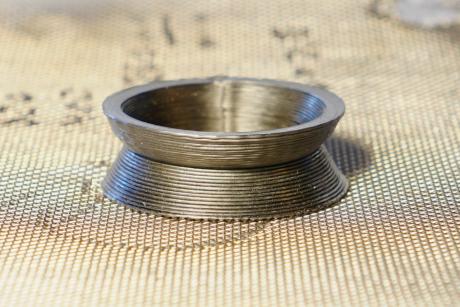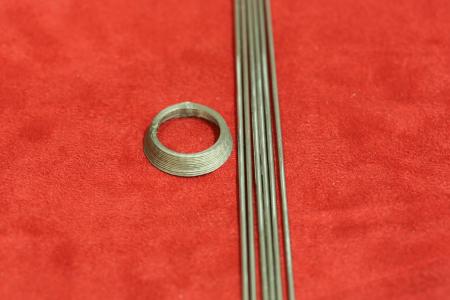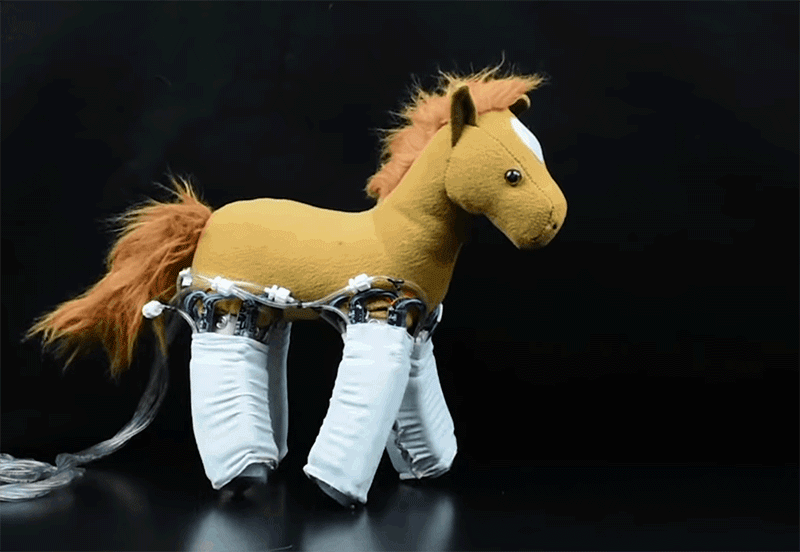3D Printed Metallic Glass Demonstrates Benefits of Both Metal and Thermoplastics
A team of researchers led by Jan Schroers, Professor of Mechanical Engineering and Materials Science at Yale, has developed a way to 3D print objects from metallic glass. The material is stronger than metal yet has the pliability of plastic, which makes it extremely valuable. The research is published in a paper entitled “3D printing metals like thermoplastics: Fused filament fabrication of metallic glasses.“
Extrusion-based 3D printing of metals is still a challenge, but bulk metallic glasses, or BMGs, can undergo continuous softening upon heating, like thermoplastics can. The research team, which also included researchers from Desktop Metal as well as MIT, demonstrated that BMGs can be used to create solid, strong metal components under ambient conditions similar to those in thermoplastic 3D printing.
“It was even surprising to us how practical this process is once we had the processing conditions figured out,” Schroers said.
Metal 3D printing, while gradually becoming more accessible and affordable, is still quite costly, and powder-based 3D printing is prone to flaws and imperfections, which make it even more expensive. The BMG research could save a lot of money and resources for manufacturers, and also eliminate the need to choose between the benefits of thermoplastics and metals.
The researchers worked with a well-characterized and readily available BMG material made from zirconium, titanium, copper, nickel and beryllium. They used amorphous rods one millimeter in diameter and 700 millimeters in length. They used an extrusion temperature of 460°C and an extrusion force of 10 to 1000 Newtons to force the softened fibers through a 0.5 diameter nozzle. A surprise came when they characterized the 3D printed parts.
“We expected high strength in the parallel-to-the-printing orientation, but were very surprised by the strength in the perpendicular orientation,” said Jittisa Ketkaew, a co-author and graduate student in the Schroers lab.
In theory, a wider range of BMGs can also be 3D printed using the researchers’ method.
“We have shown theoretically in this work that we can use a range of other bulk metallic glasses and are working on making the process more practical and commercially usable to make 3D printing of metals as easy and practical as the 3D printing of thermoplastics,” said Schroers.
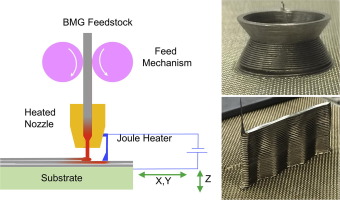 There is potential for this method to be used in numerous applications, said Punnathat Bordeenithikasem, a co-author and recent Yale graduate who is currently working as a postdoctoral fellow at the NASA Jet Propulsion Laboratory, California Institute of Technology.
There is potential for this method to be used in numerous applications, said Punnathat Bordeenithikasem, a co-author and recent Yale graduate who is currently working as a postdoctoral fellow at the NASA Jet Propulsion Laboratory, California Institute of Technology.
“Beyond prototyping, the achievable properties of the printed parts accompanied by the versatility in part design makes this 3D printing technology suitable for fabricating high-performance components for medical, aerospace, and spacecraft applications,” said Bordeenithikasem.
Authors of the paper include Michael A. Gibson, Nicholas M. Mykulowycz, Joseph Shim, Richard Fontana, Peter Schmitt, Andrew Roberts, Jittisa Ketkaew, Ling Shao, Wen Chen, Punnathat Bordeenithikasem, Jonah S. Myerberg, Ric Fulop, Matthew D. Verminksi, Emanuel M. Sachs, Yet-Ming Chiang, Christopher A. Schuh, A. John Hart, and Jan Schroers.
Discuss this and other 3D printing topics at 3DPrintBoard.com or share your thoughts below.
Soft Robotic Sheets Can Make Inanimate Objects Move
Among 3D printing’s many applications, the technology often crosses over into the field of robotics, including soft robotics. Soft robotics is a field that has been changing the way people look at robots, taking them from rigid metal creations to something much more fluid and flexible. Applications include synthetic muscle, prosthetics, search and rescue tools, and more. Now researchers at Yale University are creating soft robots from everyday objects.
The researchers created “skins” by embedding sensors and remotely operated actuators into elastic sheets. When those skins were wrapped around objects, the objects could move, grasp, and even walk. A stuffed horse was able to move its legs when wrapped with the sheets, and a foam tube was able to squirm. The research is described in a paper entitled “OmniSkins: Robotic skins that turn inanimate objects into multifunctional robots.“
Rebecca Kramer-Bottiglio, Assistant Professor of Mechanical Engineering and Materials Science and leader of the research, said that the sheets could be used to create improvised robots that could be used in disaster situations, for example.
“A designer could quickly construct a robot using the robotic skins wrapped around whatever deformable materials they have access to and stick a camera on it, and then deploy the robot for exploration of small or dangerous spaces,” she said. “Robotic skins can be applied to, removed from, and transferred between different objects, and used in combination to create many different configurations to perform many different tasks.”
Kramer-Bottiglio and her colleagues plan to use 3D printing to build additional components for testing the robotic sheets, as well as creating clay structures that can morph into different shapes.
“I’m really excited to see what other people will do with robotic skins,” Kramer-Bottiglio said. “The possibilities are endless.”
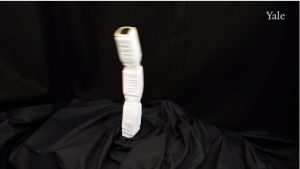 The field of soft robotics encompasses a wide variety of production techniques, although 3D printing has been one of the most common methods of fabricating them. Soft robotics has the potential to eliminate many components from traditional robots, doing away with circuits and other clunky parts in favor of actuation by light or chemical reaction. With this new way of looking at robots, they can be made and activated more easily, and used in situations that involve small or unknown spaces.
The field of soft robotics encompasses a wide variety of production techniques, although 3D printing has been one of the most common methods of fabricating them. Soft robotics has the potential to eliminate many components from traditional robots, doing away with circuits and other clunky parts in favor of actuation by light or chemical reaction. With this new way of looking at robots, they can be made and activated more easily, and used in situations that involve small or unknown spaces.
“This is a very exciting study that demonstrates the versatility and adaptability of soft robotics,” said Conor Walsh, an Associate Professor of Engineering and Applied Sciences at Harvard University. “The idea that we can have a soft and flexible sheet, wrap it around any surface, have it learn what it is attached to and then move it in some desired way has lot of potential.”
Soft robots can be made out any number of flexible materials, but the researchers’ idea is novel in that it can transform ordinary objects into robots just by wrapping them in fabric. As Kramer-Bottiglio pointed out, this means that in an emergency situation, any flexible item that happened to be at hand could be quickly turned into a search and rescue bot – or, in a less urgent situation, kids could turn their favorite stuffed animals into companions that could move around the house. Whether that’s fun or creepy is a matter of opinion, but it’s hard to argue against this new method of robot creation as being potentially very useful in the future.
Authors of the paper include Joran W. Booth, Dylan Shah, Jennifer C. Case, Edward L. White, Michelle C. Yuen, Olivier C. Choiniere and Rebecca Kramer-Bottiglio.
Discuss this and other 3D printing topics at 3DPrintBoard.com or share your thoughts below.

